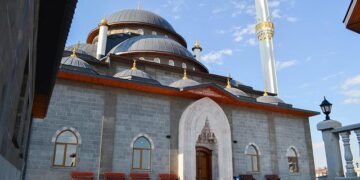ByTom Metcalfe
Published October 25, 2023
• 9 min read
Declassified photographs of the Middle East from Cold-War spy satellites have revealed what may be hundreds of previously unknown Roman forts in the deserts of Syria and Iraq—a discovery that suggests the ancient border between the Romans and their enemies to the east was a place of cultural exchange, not constant warfare.
Until now, researchers knew of the remains of only about 100 forts in the region built by the Roman army mainly in the second and third centuries A.D., thanks to evidence from aerial photographs taken in the 1920s and 1930s by Antoine Poidebard. The priest, pioneering archaeologist and pilot observed that the remains of the forts he viewed from his biplane formed a defensive line running roughly north to south, which he theorized marked a fixed military barrier against raids by Persians and the region’s nomadic tribes.
But the declassified photos, taken between 1960 and 1986 by the American CORONA and HEXAGON satellites, reveal nearly 400 additional possible forts, distributed in a pattern that suggests they were used to facilitate caravan trade, troop movements, and communication across the region, rather than simply serving as a means of defense.
“This conception of these forts as demarcating a border between two places is clearly incorrect,” says Jesse Casana, an archaeologist at Dartmouth College and lead author of a Dartmouth study on the spy satellite discoveries and their implications for ancient history, published today in the journal Antiquity.
“They don’t look like wall meant to keep people out,” Casana observes. “[T]hey look like they’re placed to facilitate movement.”
Cold-War spy satellites
In his landmark 1934 book La trace de Rome dans le désert de Syrie (The Remains of Rome in the Syrian Desert) Father Poidebard identified the sites of 116 Roman forts that he thought lay along the frontier with the Persian state, which was ruled by the Parthians until A.D. 224 and later by the Sasanians. He assumed the forts followed a military road called the Strata Diocletiana (Diocletian’s Road) that had been built across Syria during that emperor’s reign in the late third century.
But Casana says what appeared to be a defensive line is actually a product of discovery bias, and although Poidebard’s pioneering work has been invaluable for generations of archaeologists and historians, it does not reflect the true state of the frontier.
“If he’d flown his biplane everywhere, he would have found a lot more forts—but he didn’t have the capability or the technology to do that at the time,” Casana notes.
That technology didn’t arrive until 1960, when the U.S. began its CORONA spy satellite flights. The program operated until 1972 and consisted of 130 satellites carefully synchronized to take detailed photographs over sites of military interest; another 19 satellites were launched under the HEXAGON program, which ran until 1986. Canisters of film were ejected from the satellites and fell back to Earth, where they were collected in the Pacific Ocean by the U.S. military.
Some canisters were lost; but those that were recovered by USAF aircraft included photographs of the territory covered thirty years earlier by Poidebard, says Casana. The CORONA imagery was declassified in by the U.S. in 1995 and HEXAGON in 2019.
A fading frontier
Those spy satellite photographs captured in the Middle East half a century ago now provide archaeologists with a unique record of how the terrain in the region once looked. Many of the archaeological remains identified in the images have since disappeared with the rapid growth of cities, construction of reservoirs, and scourge of conflict.
There were also significant changes in the few decades between Poidebard’s aerial surveys and the Cold War images: Of the 116 Roman forts identified by biplane, only 38 could be located in the satellite photographs, Casana says.
Those 38 forts, however, enabled the researchers at Dartmouth College to fix a baseline from Poidebard’s survey. They then manually scanned more than 2,000 photographs from the satellites and identified more than 10,000 possible archaeological sites across a 300,000 square-mile area; these were then winnowed down to just 396 sites that were likely Roman forts, based on rules for size and shape established by Poidebard. Many are square and between 160 and 330 feet long on each side, but some are much larger.
The new distribution of forts is very different than that seen by Poidebard, who described a line of structures along the Strata Diocletiana extending from Damascus and Bosra in Syria’s south-west to Nisibis (modern Nusaybin) on the Turkish border.
Casana’s team have identified forts far to the east of the Strata Diocletiana, near the Iraqi city of Mosul on the Tigris River; far to the west, around the Syrian city of Aleppo; and notably in the west of Syria’s Jazira region, an extremely arid region with few sources of surface water. Instead of a fixed frontier facing east, many of the forts seem to form networks between western Syria and the Tigris River, which suggests to Casana they supported trading caravans and communications across the region, as well as defensive military functions.
“The distribution was a real shock,” Casana says. “I had grown up thinking the forts formed a line on the border—but they don’t.”
Edge of an empire
The newly discovered forts provide increasing evidence for the theory that Rome’s eastern border—once seen as a static, fortified barrier against Persian and nomad raids—was instead a dynamic region with different forts occupied at different times, and trading caravans frequently crossing the region in both directions.
Archaeologist Rocco Palermo of Bryn Mawr College, who wasn’t involved in the study, says spy satellite photos have become a vital resource for researchers and their detailed examination is a crucial advance.
“This study applies a new technique to assess the distribution of forts, and proves that it followed complex dynamics like trade,” he says.
Palermo explains that Rome’s eastern border was unlike its others, where the empire faced only “barbarians” on the other side. But in the east Rome faced the Persians, an organized empire with a well-trained army. The border region was further “buffered” by nomadic tribespeople, who often acted as go-betweens for the major powers, he says.
“This was a complex and environmentally fragile region, where the nomadic tribes were an integral part of trade and cultural encounters,” Palermo adds.
Some of the newly discovered sites have been earmarked for future archaeological investigations on the ground, but others lie in active military zones off-limits to researchers.
Archaeologist Lidewijde de Jong at the University of Groningen in the Netherlands, who also wasn’t involved in the study, says the research also illustrates the enormous potential of aerial photography and satellite imagery for the study of ancient landscapes.
The study “focuses on a region where opportunities for archaeological excavations are limited,” whether due to political instability, modern development of the landscape, or economic crises, she notes.
>>> Read full article>>>
Copyright for syndicated content belongs to the linked Source : National Geographic – https://www.nationalgeographic.com/history/article/roman-forts-archaeology-cold-war-spy-satellite-photos































